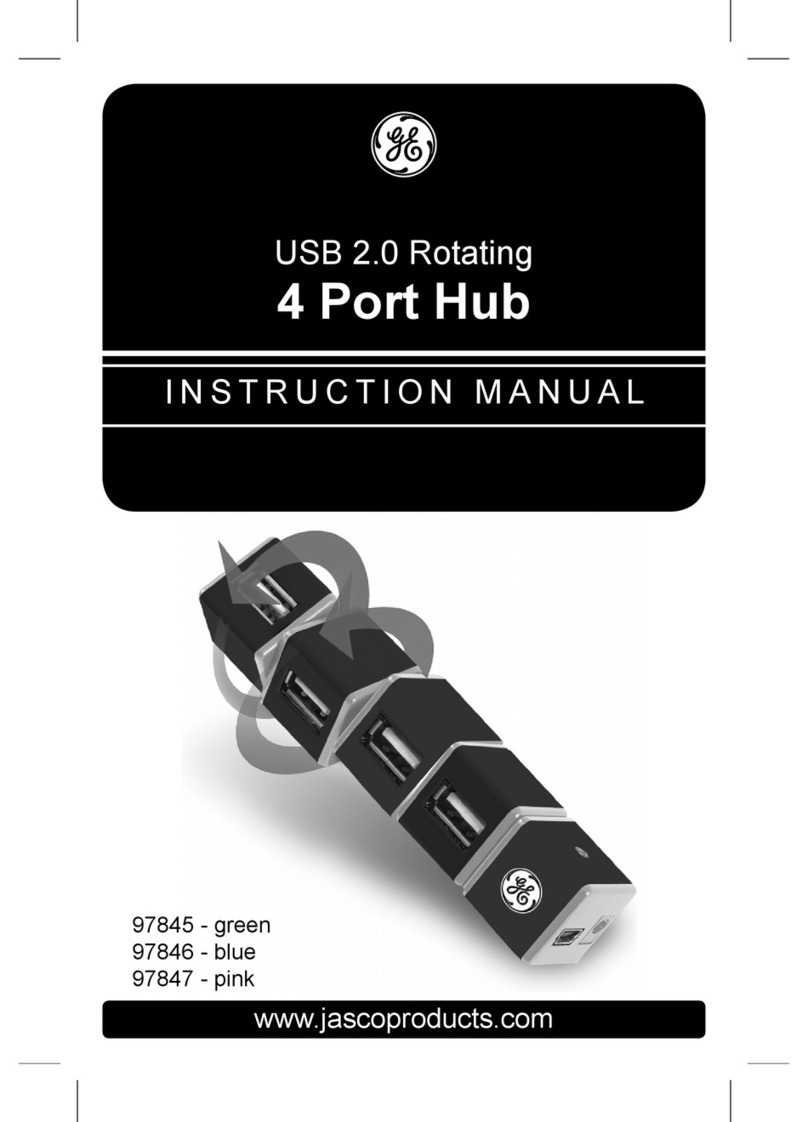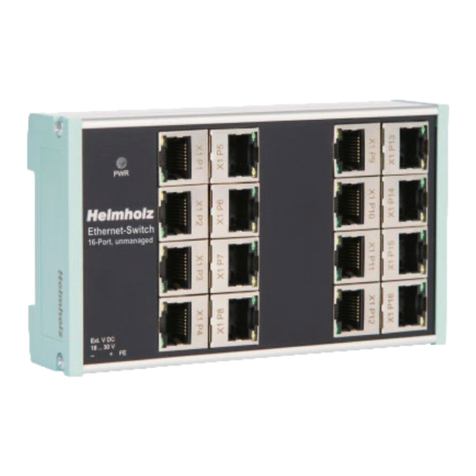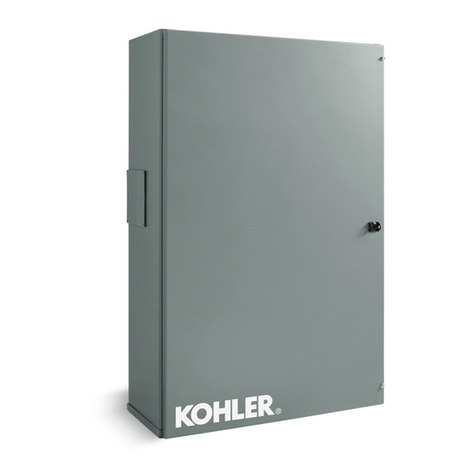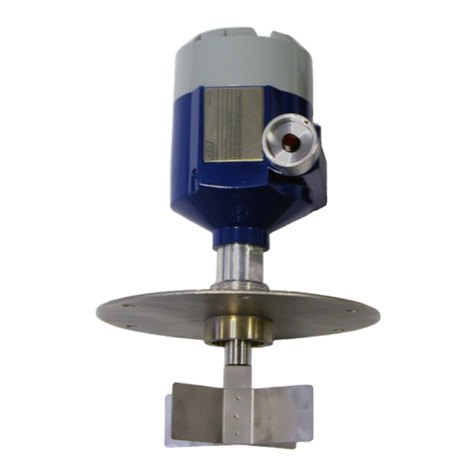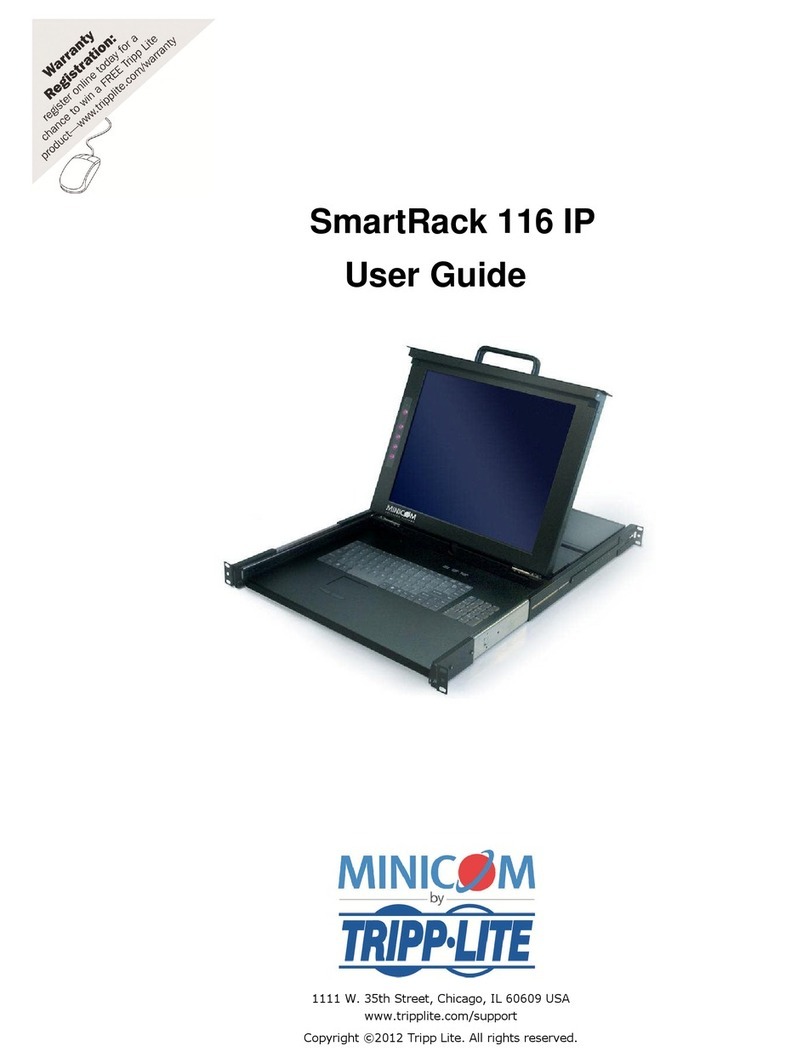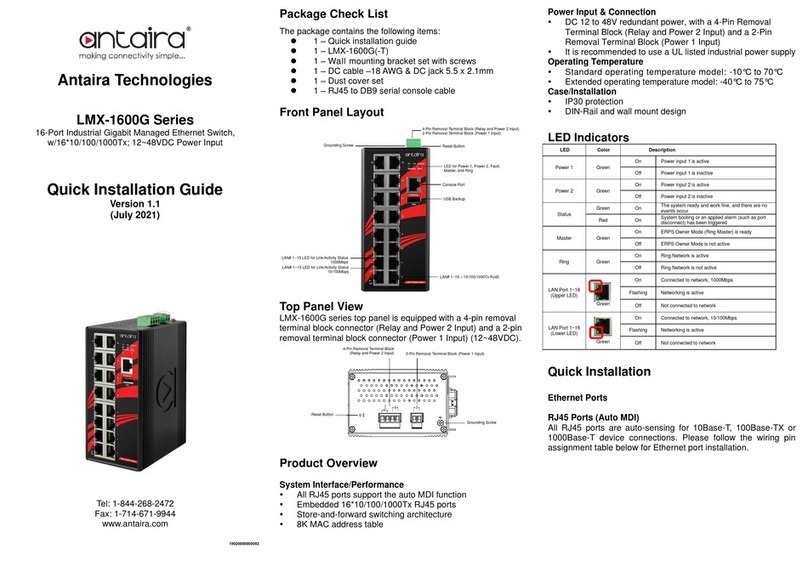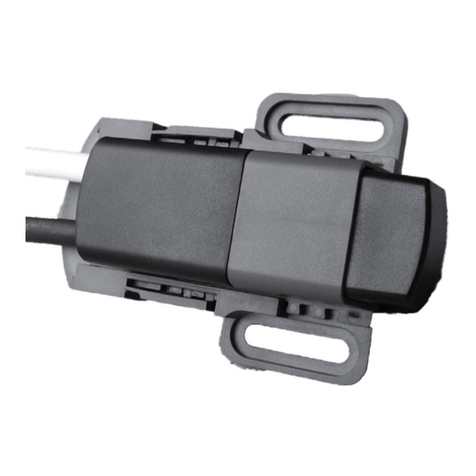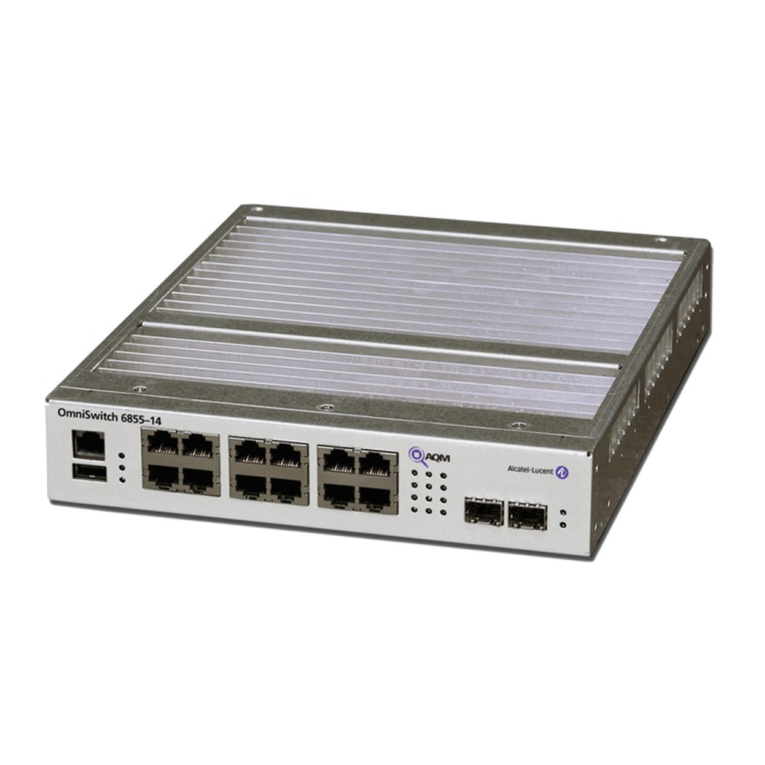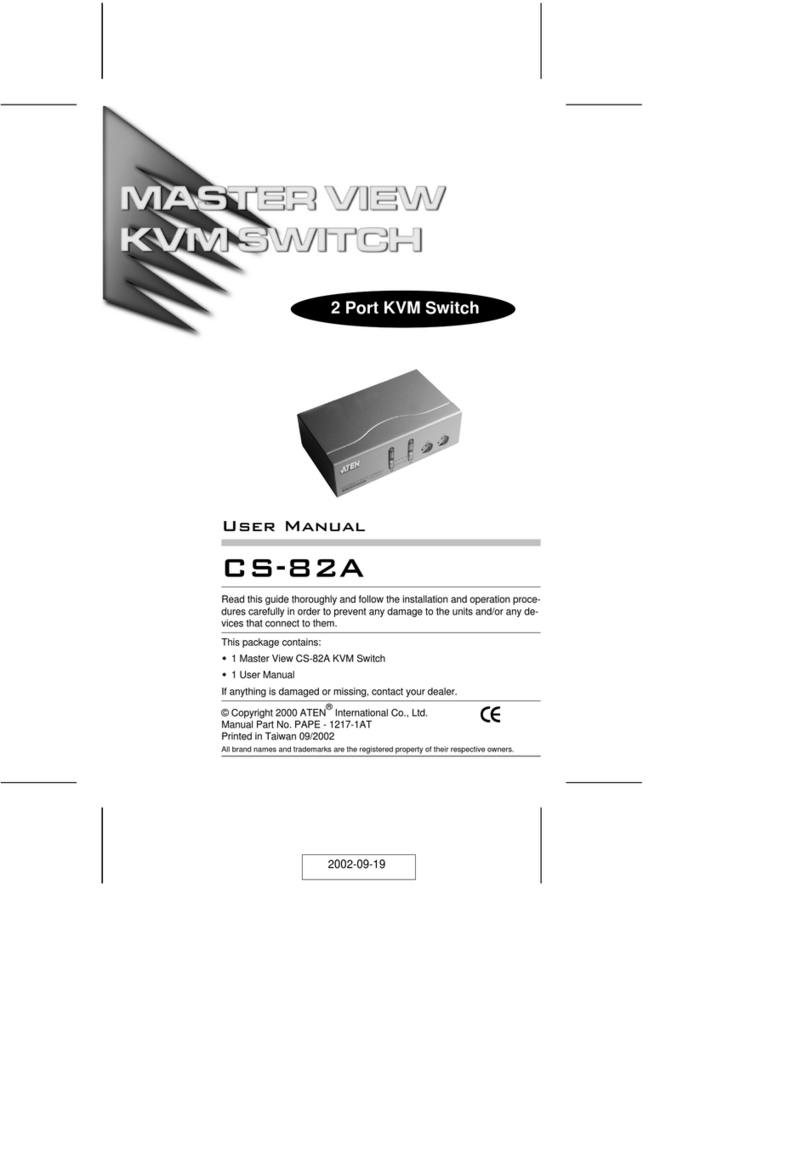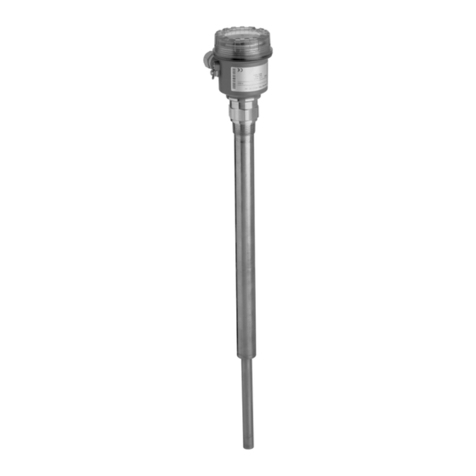Allmatic ARGO 1 Series User manual

ITA ENG FRA ESP DEU POR
6-1622192 rev. 14 21/09/2012 1/9
SERIE ARGO 1- ARGO 2
Q
UADRI
DI
COMANDO
PROGRAMMABILI
PER
1
O
2 MOTORI
C
ON
GESTIONE
INDIPENDENTE
DEI
RALLENTAMENTI
.
1. Introduzione.
ATTENZIONE: NONINSTALLARE IL QUADRO DICOMANDO SENZAPRIMA AVER LETTO LE ISTRUZIONI !!!
Il quadro di comando ARGO è un'apparecchiatura universale adatta a gestire l'azionamento ed il controllo di cancelli a 1 o 2 ante
con motori a 230V in corrente alternata e potenza fino a 600W cadauno.
Il funzionamento a tempo del quadro di comando , essendo di tipo elettronico, è estremamente preciso. È possibile però
che, dovuto al tipo di motore normalmente utilizzato, l’angolo di percorrenza dell’anta del cancello sia fortemente influenza-
to dagli attriti che l’anta stessa incontra durante la corsa. Di conseguenza, anche se il tempo viene correttamente imposta-
to, l’angolo di apertura delle ante può non essere sempre quello desiderato. Pertanto si consiglia all’installatore di tenerne
conto aumentando, se necessario, i tempi di lavoro nella misura più consona all’installazione e facendo comunque attenzione al fat-
to che un aumento eccessivo del tempo potrebbe mascherare i rallentamenti in apertura e chiusura (vedi paragrafo 6).
Per il corretto funzionamento è inoltre indispensabile l’installazione dei fermi meccanici in apertura e chiusura (vedi fig. pag. 6).
2. Configurazione.
3. Collegamenti elettrici.
Uscita elettroserratura
12 Vac 12W Max
Spia cancello aperto
24 Vac 2W max.
Connettore
trasformatore
Dip-switch
Fusibili
Connettore
modulo
radio
Trimmer di
regolazione
Pulsantedi
apprendimento
Alimentazione
230 Vac 50 Hz.
Molex
ricevitore
radio
LEGENDA:
FOTO CH = Fotocellula Chiusura
FOTO AP = Fotocellula Apertura
AP = Apri
CH = Chiudi
Com = Comune
PP = Pulsante passo passo
ANT = Antenna
PED = Pulsante pedonale
F.C. 1 = Finecorsa 1
F.C. 2 = Finecorsa 2
Qualunque contatto
Normalmente Chiuso (N.C.)
deve essere ponticellato
se non utilizzato.
3 4 5 6 7 8 9 10 11 12
Motore 2 Motore 1
Alimentazione
Fotocellule
(vedi cap 7.6).
Lampeggiante 230 Vac 60W max
N.B.: USARE LAMPEGGIANTE B.RO LIGHT FIX
(Senza circuito di auto lampeggio
)

ITA ENG FRA ESP DEU POR
6-1622192 rev. 14 21/09/2012 2/9
AVVERTENZE DI SICUREZZA
•
••
•
Alcuni punti della scheda elettrica sono sottoposti a tensioni pericolose. Pertanto l’installazione, l’apertura e la programmazione del
quadro deve essere svolta solamente da personale qualificato. Tutte le operazioni svolte dall’utente non richiedono l’apertura del box.
•
••
•
Prevedere l’uso di un mezzo che assicuri la disconnessione onnipolare dall’alimentazione della centralina. Questi può essere o un
interruttore (collegato direttamente ai morsetti di alimentazione) con una distanza minima dei contatti di 3 mm in ciascun polo, oppure un
dispositivo integrato nella rete di alimentazione.
•
Per il collegamento all’alimentazione della scheda e dei motori, è preferibile usare cavi a doppio isolamento come previsto dalle normative
e comunque con sezione minima del singolo conduttore non inferiore a 1 mm
2
e non superiore a 2.5mm².
•
Il costruttore declina ogni responsabilità in caso di inosservanza delle presenti avvertenze.
•
Questa centrale è dotata di un circuito di test delle fotocellule. Per il cablaggio di queste ultime, vedere lo schema a pag. 5.
•
Si consiglia di controllare gli assorbimenti di tutti i dispositivi collegati alle uscite della centralina, quali spie luminose, fotocellule,
dispositivi di sicurezza, ecc. in modo da rientrare nei limiti indicati nella tabella delle caratteristiche tecniche. Non si garantisce il corretto
funzionamento del prodotto in caso di inosservanza di tali limitazioni.
•
Per massimizzare la portata del ricevitore è necessario porre attenzione al posizionamento dell’antenna ricevente: non deve essere posta
a ridosso di muri e/o schermature metalliche. I morsetti del cavo schermato dell’antenna vanno ben serrati.
•
L’antenna accordata è necessaria per ottenere le massime prestazioni di portata dall’apparecchio, in caso contrario la portata si
ridurrebbe a pochi metri.
Il quadro di comando viene fornito con i dip-switch impostati come indicato nella figura a fianco.
Nelle tabelle vengono riassunti le funzione selezionabili tramite questi dip-switch.
4. Impostazioni di default.
5. Apprendimento trasmettitori.
L’apprendimento di ogni singolo trasmettitore deve essere effettuato sempre con il cancello chiuso.
Premendo e rilasciando il tasto apprendimento si accende il lampeggiante; trasmettere, quindi, con il
trasmettitore da apprendere, considerando che:
•
i pulsanti vanno appresi uno alla volta.
•
il primo pulsante appreso funziona come passo-passo.
•
il secondo pulsante appreso svolge la funzione di pedonale (vedi paragrafo 11.5 ).
•
il terzo pulsante appreso funziona come simulazione radio del tastino DOWN sulla scheda.
•
il quarto pulsante appreso funziona come simulazione radio del tastino UP sulla scheda.
Si consiglia di apprendere i tasti a, b, c, d in sequenza.
Quando un tasto DOWN o UP viene attivato all’interno di un apprendimento, (tasto “c” o tasto “d” del trasmettitore), il lampeggiante esegue un
breve lampeggio, questo per indicare che il tasto è stato visto dal sistema. E’ importante quindi verificare sempre che ogni trasmissione di ogni
tasto venga ricevuta correttamente dalla centrale.
NOTA: i successivi apprendimenti possono ora eseguirsi anche con il telecomando memorizzato. Le modalità operative sono riportate
in seguito.
a
c
b
d
PP
DOWN
PEDONALE
UP
TRASMETTITORE
N°dip Funzione Dip OFF Dip ON
1 Passo passo Apre-stop-chiude Apre-chiude
2 Colpo d’ariete Abilitato Non abilitato
3 Fotocellule Arresto movimento arresto e
inversione
4 Prelampeggio Non attivo Attivo
5 condominiale Non attiva Attiva
6 Controllo sicurezze Abilitata Non abilitata
7 funzionamento
Finecorsa fine operazione inizio
rallentamento
8
Gestione finecorsa
(se dip 7 è ON)
Inizio
rallentamento sul
finecorsa in
APERTURA
Inizio
rallentamento sul
finecorsa in
CHIUSURA
Gestione finecorsa
(se dip 7 è OFF) Finecorsa come
fine operazione Finecorsa non
collegati
9 Apertura cancello Simmetrica Asimmetrica
10 Rich.Automatica
immediata Disabilitata Abilitata
N°dip Funzione Dip OFF Dip ON
1 Passo passo Apre-stop-chiude Apre-chiude
2 Colpo d’ariete Abilitato Non abilitato
3 Fotocellule Arresto movimento Arresto e
inversione
4 Prelampeggio Non attivo Attivo
5 condominiale Non attiva Attiva
6 Controllo sicurezze Abilitata Non abilitata
7 Funzionamento
Finecorsa in
Chiusura Fine operazione Inizio
rallentamento in
chiusura
8 funzionamento del
Finecorsa di
Apertura Fine operazione Inizio
rallentamento in
apertura
9 ***** ***** *****
10 Rich.Automatica
immediata Disabilitata Abilitata
Argo 1: Riassunto delle funzioni selezionabili da dip-switch. Argo 2: Riassunto delle funzioni selezionabili da dip-switch.
5.1 Memorizzazione dei trasmettitori / del trasmettitore di preparazione a 4 tasti.

ITA ENG FRA ESP DEU POR
6-1622192 rev. 14 21/09/2012 3/9
6. Regolazioni.
Tagliando il ponticello indicato in figura è possibile
aumentare il tempo di lavoro.
0°
+
-
WORK TIME
7” 55” 0°
+
-
WORK TIME
55” 2’10”
TRASLAZIONE TEMPI
0°
+
-
2nd: WING D.
7” 55” 0°
+
-
55” 2’10”
2nd: WING D.
TRASLAZIONE TEMPI
NOTA: Le regolazioni del trimmer effettuate durante il
moto del cancello non sortiscono nessun effetto
immediato. Diventano effettive solo dopo lo stop del
cancello o dopo lo spegnimento e successiva
accensione della centrale.
La maggiorazione dei tempi non influisce sul tempo di
richiusura automatica e sul tempo di pedonale.
Regolazione tempo di
richiusura automatica.
+
A. RECL. TIME
0° 270°
Regolazione del
tempo di lavoro.
0°
+
WORK TIME
0° 270°
ARGO2: Regolazione tempo di
ritardo o di lavoro della 2 anta.
ARGO1: Regolazione del tempo
di apertura pedonale.
- - + -
2nd: WING D.
0° 270°
Nella parte finale del loro movimento (apertura e/o chiusura) le ante del cancello eseguono un rallentamento proporzionale al
tempo di lavoro impostato (“WORK TIME” per cancello simmetrico, “WORK TIME” e “2nd:WING D.” per cancello asimmetrico).
Nei cancelli simmetrici può essere necessario inserire un tempo di ritardo della seconda anta. Impostare il dip-switch 9 su OFF
(modalità simmetrica) e regolare questo tempo di ritardo con il trimmer “2nd: WING D“.
Nel caso di Argo 2 motori, per cancelli asimmetrici è possibile regolare il tempo di lavoro della seconda anta diverso dal tempo di
lavoro della prima anta. Impostare il dip-switch 9 su ON e regolare il tempo di lavoro della seconda anta con il trimmer “2nd:
WING D“. In questo caso, WORK TIME corrisponde al tempo di lavoro della prima anta.
E’ possibile regolare il moto del cancello, par-
tendo sempre da automazione chiusa, utiliz-
zando in modo appropriato gli appositi
trimmer (“WORK TIME”, “A.RECL.TIME”,
“2nd:WING D.”) e scegliendo opportunamen-
te l’impostazione dei DIP-SWITCH, secondo
il tipo di installazione e le esigenze
dell‘installatore.
Come si può ben vedere dalle figure, i
trimmer hanno un’escursione tra 0° e 270°
all’interno della quale si ottiene con buona
precisione la regolazione desiderata.
6.1 Regolazione del moto del cancello.
Funzione valida solo per i modelli B.RO a codice variabile.
1) Premere, con l’aiuto di una grafetta, il tasto nascosto di un trasmettitore già precedentemente
appreso. L’entrata in apprendimento è segnalata dall’accensione del lampeggiante.
2) Premere il tasto del trasmettitore che si vuole memorizzare, il lampeggiante esegue un lampeggio
(due volte se il codice è nuovo, una volta se era già stato appreso). La centrale torna in modo di
funzionamento normale e il nuovo trasmettitore può attivare il motore.
PREMERE il
tasto nascosto
“e”
led
a
b
c d
a b
led
1) Scollegare l’alimentazione.
2) Fornire l’alimentazione tenendo premuto il tasto apprendimento ancora per 4-5 s. Il lampeggiante
si accende per un tempo totale di circa 10 s. Quando il lampeggiante si spegne, tutti i trasmettitori
sono cancellati, i parametri riportati ai valori di fabbrica e il modulo memoria viene predisposto per la
ricezione del codice fisso o del codice variabile a seconda di come si è impostato il relativo Jumper.
Funzione valida solo per i modelli B.RO a codice variabile e memoria estraibile.
1) Premere un tasto qualsiasi del trasmettitore di apertura memoria, preventivamente abilitato tramite
lo strumento di programmazione B.RO PRO o B.RO BASIC. Il ricevitore si porta in apprendimento (si
accende il lampeggiante).
2) Premere il tasto del trasmettitore che si vuole abilitare, il lampeggiante esegue un lampeggio (due
volte se il codice è nuovo, una volta se era già stato appreso). La centrale torna in modo di
funzionamento normale e il nuovo trasmettitore può attivare il motore.
a b
Lampeggiante
a b
Lampeggiante
Accendere +
Premere auto
apprendimento
led
5.2 Apprendimento con il tasto nascosto di un trasmettitore già appreso.
5.3 Apprendimento con un trasmettitore di apertura memoria abilitato.
5.4 Cancellazione di tutti i trasmettitori e ripristino parametri ai valori di fabbrica.

ITA ENG FRA ESP DEU POR
6-1622192 rev. 14 21/09/2012 4/9
6.2 Regolazione di coppia del motore.
La centrale è dotata di un trimmer di regolazione della coppia fornita al motore, in modo da limitare la forza del cancello su eventuali ostacoli che
dovessero frapporsi durante il moto.
+
-
POWER
0° 270°
Per regolare la coppia erogata dal motore, agire nel seguente modo:
•
Agire sul trimmer di regolazione per impostare la coppia desiderata, tenendo presente che il trimmer al minimo (tutto in
senso antiorario) corrisponde a coppia minima, mentre il trimmer al massimo (tutto in senso orario)
corrisponde a coppia massima.
•
Avviare il motore e valutare la coppia.
•
Se la regolazione non soddisfa, arrestare il motore regolare nuovamente il trimmer, quindi riavviare nuovamente il motore.
•
E’ consigliabile regolare la coppia prima di regolare il moto del cancello .
6.3 Regolazione del tempi di richiusura automatica.
A. RECL. TIME
+
-
270°
0°
La richiusura automatica è una funzione che permette di richiudere automaticamente il cancello allo scadere del
tempo di pausa impostabile con il trimmer “A. RECL. TIME”. L’abilitazione o la disabilitazione della funzione è affidata al
trimmer stesso, infatti:
•
Impostando il trimmer tutto in senso antiorario (al minimo) la richiusura automatica è disabilitata.
•
Impostando il trimmer in senso orario si inserisce la richiusura automatica.
NOTA: Le regolazioni del trimmer effettuate durante il moto del cancello non sortiscono nessun effetto
immediato. Diventano effettive solo dopo lo stop del cancello o dopo lo spegnimento e successiva accensione
della centrale.
E' importante cambiare la configurazione dei dip-switch
solo a scheda spenta.
7.2 Colpo di ariete.
Se l’automazione è dotata di un elettroserratura, a cancello chiuso, il motore agisce in chiusura per un breve tempo prima di iniziare la fase di
apertura. Questa funzione consente di sbloccare in ogni caso l’elettroserratura anche in condizioni atmosferiche gravose (ad esempio ghiaccio).
Il colpo di ariete in apertura è abilitato e l’elettroserratura viene gestita dalla centrale. Il ciclo di default
prevede un tempo minimo del colpo di ariete in fase di apertura e nullo in fase di chiusura che posso-
no venire modificati come descritto nel paragrafo 8.1. L’elettroserratura rimane attiva per un tempo pari al
tempo di ritardo della seconda anta.
E’ possibile impostare la risposta della centrale a successivi comandi dati dal telecomando o dal pulsante di passo-passo.
Il comando di passo-passo può essere impartito sia tramite l’apposito ingresso (vedi pulsante di passo-passo sulla morsettiera), sia tramite la
pressione del primo tasto di un trasmettitore memorizzato (vedere paragrafo 5 apprendimento trasmettitori).
7.1 Funzione di PASSO-PASSO.
L’automatismo esegue la sequenza apre - chiude - apre - chiude
ON
OFF
1 2 3 4 5 6 7 8 9 10
ON
OFF
1 2 3 4 5 6 7 8 9 10
L’automatismo esegue la sequenza apre - stop - chiude - stop.
ON
OFF
1 2 3 4 5 6 7 8 9 10
ON
OFF
1 2 3 4 5 6 7 8 9 10
Il colpo di ariete è completamente disabilitato ma l’uscita per l’elettroserratura è ancora abilitata (utile se
si ha una serratura magnetica).
Quando viene interrotto il fascio tra le fotocellule del trasmettitore e quelle del ricevitore, queste ultime modificano il comportamento della centrale
secondo le seguenti modalità:
7.3 Fotocellule di protezione e di sicurezza.
A) durante il ciclo di apertura: Se le fotocellule rivelano un ostacolo, non viene interrotto il moto del
cancello.
B) durante il ciclo di chiusura: Se le fotocellule rivelano un ostacolo, la centrale blocca e inverte il movi-
mento facendo riaprire completamente il cancello.
ON
OFF
1 2 3 4 5 6 7 8 9 10
ON
OFF
1 2 3 4 5 6 7 8 9 10
A) durante il ciclo di apertura: Se le fotocellule rivelano un ostacolo, la centrale blocca il movimento del
cancello. Quando l’ostacolo viene rimosso, il moto riprende in APERTURA fino a fine ciclo.
B) durante il ciclo di chiusura: Se le fotocellule rivelano un ostacolo, la centrale blocca il movimento del
cancello. Quando l’ostacolo viene rimosso, il moto riprende in APERTURA fino a fine ciclo.
7. Funzioni selezionabili tramite DIP-SWITCH.

ITA ENG FRA ESP DEU POR
6-1622192 rev. 14 21/09/2012 5/9
7.4 Funzione di Prelampeggio.
Prelampeggio attivo. Il movimento del cancello è sempre preceduto da un prelampeggio che ha la finalità
di avvisare l’utente che ha inizio il movimento. Il tempo di prelampeggio è fissato a circa 2 secondi.
7.5 Funzione Condominiale.
ON
OFF
1 2 3 4 5 6 7 8 9 10
ON
OFF
1 2 3 4 5 6 7 8 9 10
Il lampeggiante segnala con un lampeggio lento (circa 1 ogni 2 secondi) l’apertura del cancello e con uno più veloce (circa 1 al secondo) la chiusu-
ra del cancello.
Prelampeggio non attivo.
Funzione condominiale attiva.
ON
OFF
1 2 3 4 5 6 7 8 9 10
ON
OFF
1 2 3 4 5 6 7 8 9 10
Ogni comando impartito via radio o con il pulsante di passo-passo provoca solo l’apertura del cancello. La richiusura è affidata alla funzione di
richiusura automatica, che dovrà pertanto essere necessariamente attivata in quanto ogni comando di chiusura viene ignorato (il pulsante chiudi è
disabilitato).
Funzione condominiale non attiva.
7.6 Test sul funzionamento delle fotocellule.
Questa centrale è dotata di un sistema che permette di effettuare un controllo sul funzionamento delle fotocellule prima di ogni azionamento del
motore, si ha così la possibilità di incrementare la sicurezza del sistema in caso di danneggiamento del fotodispositivo (p.e. relé di uscita incollato)
o di un cortocircuito indesiderato sull’ingresso fotocellule.
Questo controllo viene effettuato dopo che la centrale ha ricevuto un comando a muovere, ma prima di dare tensione al motore.
Note di installazione:
L’alimentazione delle fotocellule ALLMATIC, o compatibili, deve essere collegata in morsetti differenti a seconda che si voglia rendere attivo o non
attivo il test sulle fotocellule. Lo schema corretto per il cablaggio di una coppia di fotocellule è il seguente:
Schema alimentazione fotocellule con
TEST NON ATTIVO (DIP6 ON)
Schema alimentazione fotocellule con
TEST ATTIVO (DIP6 OFF)
24 RX
24
TX
24 RX
24
TX
13 14 15
13 14 15
DIP6 OFF: Test fotocellule attivo. In caso di guasto
delle fotocellule non viene eseguito nessun comando.
DIP6 ON: Test fotocellule non attivo.
Nota: Il test delle fotocellule, se attivo, comporta un
ritardo di attivazione del motore di circa un secondo dal
mo mento di avvenuta ricezione del comando.
7.7 Modalità di intervento dei finecorsa.
La fine delle operazioni di apertura e di chiusura è affidata al tempo di
lavoro e alle impostazioni dei dip 7 e 8.
NOTA: se non sono installati dei finecorsa, impostare il dip 7 a OFF e il dip 8 a ON (Vedi schema a fianco):
ON
OFF
1 2 3 4 5 6 7 8 9 10
7.7.1 Modello ARGO2: Qualora siano installati dei finecorsa, essi intervengono con le seguenti modalità:
Inizio rallentamento solo in apertura: l’inizio della
fase di rallentamento in apertura è determinato
dall’intervento dei due finecorsa (uno per ciascuna
anta), mentre in chiusura è solo temporizzato. (si
veda lo schema seguente )
ON
OFF
1 2 3 4 5 6 7 8 9 10
Tipo finecorsa Funzione
Finecorsa 1 Fine operazione di apertura
Finecorsa 2 Fine operazione di chiusura
ON
OFF
1 2 3 4 5 6 7 8 9 10
Tipo finecorsa Funzione
Finecorsa 1 e 2
posti in apertura Inizio rallentamento in
apertura
Finecorsa chiusura Nessuna operazione
Arresto con finecorsa: la fine della operazioni di aper-
tura (finecorsa 1) o di chiusura (finecorsa 2) è deter-
minata dall’intervento del corrispondente finecorsa.
ON
OFF
1 2 3 4 5 6 7 8 9 10
Tipo finecorsa Funzione
Finecorsa 1 Nessuna operazione
Finecorsa 2 Fine operazione di chiusura
Arresto senza finecorsa di apertura: la fine della sola
operazione di chiusura è determinata dall’intervento
del corrispondente finecorsa.

ITA ENG FRA ESP DEU POR
6-1622192 rev. 14 21/09/2012 6/9
FC 1 FC 2
Fine corsa 1 e 2 posti per
rallentamenti in apertura Fine corsa 1 e 2 posti per
rallentamenti in chiusura
FC 1 FC 2
Schema concettuale delle
funzioni dei finecorsa come
inizio rallentamenti
An ta B An ta A
Esemp io di funzio namento simmet rico:
Tempo di apertura anta A = Tempo di apertura anta B
Anta B Anta A
Esempio di fu nzionamen to asim met rico:
Tem po di apert ura an ta B > Tempo d i apertura a nta A
Tem po di apert ura an ta A > Tempo d i apertura a nta B
7.8 Apertura simmetrica/asimmetrica ( Solo per argo 2 motori).
con il dip–switch in questa posizione il cancello si apre/chiude in modo simmetrico (un tempo di lavoro per
entrambe le ante da impostare con il trimmer “WORK TIME“).
Con il dip-switch in questa posizione il cancello si apre/chiude in modo asimmetrico (tempi di lavoro distinti
per le due ante da impostare rispettivamente con i trimmer “WORK TIME“ e “2nd: WING D“).
1 2 3 4 5 6 7 8 9 10
ON
OFF
1 2 3 4 5 6 7 8 9 10
ON
OFF
ON
OFF
1 2 3 4 5 6 7 8 9 10
ON
OFF
1 2 3 4 5 6 7 8 9 10
Questa funzione permette di chiudere il cancello dopo un'interruzione del fascio delle fotocellule. Se era stato impostato un tempo di pausa, il
conteggio viene interrotto e il cancello va in chiusura.
7.9 Richiusura immediata dopo intervento fotocellule.
Richiusura dopo interruzione fascio fotocellule abilitata.
Richiusura dopo interruzione fascio fotocellule disabilitata.
7.7.2
Modello
ARGO1: Qualora siano installati dei finecorsa, essi intervengono con le seguenti modalità:
Tipo finecorsa Funzione
Finecorsa
di Apertura Fine operazione
in Apertura
Finecorsa
di Apertura Inizio rallentamento
in Apertura
ON
OFF
1 2 3 4 5 6 7 8 9 10
ON
OFF
1 2 3 4 5 6 7 8 9 10
ON
OFF
1 2 3 4 5 6 7 8 9 10
ON
OFF
1 2 3 4 5 6 7 8 9 10
Tipo finecorsa Funzione
Finecorsa
di Chiusura Fine operazione
di Chiusura
Finecorsa
di Chiusura Inizio rallentamento
in Chiusura
Inizio rallentamento solo in chiusura: l’inizio della
fase di rallentamento in chiusura è determinato
dall’intervento dei due finecorsa (uno per ciascuna
anta), mentre in apertura è solo temporizzato.
ON
OFF
1 2 3 4 5 6 7 8 9 10
Tipo finecorsa Funzione
Finecorsa apertura Nessuna operazione
Finecorsa 1 e 2
posti in chiusura Inizio rallentamento in
chiusura
Fermo meccanico
apertura
Fermo meccanico
chiusura
Fermi meccanici
apertura
Fermo meccanico
chiusura
Fermi meccanici
apertura

ITA ENG FRA ESP DEU POR
6-1622192 rev. 14 21/09/2012 7/9
8. Impostazione avanzate.
8.1 Variazione del tempo del colpo d’ariete
Qualora il tempo di attivazione del colpo d’ariete o di attivazione dell’elettroserratura o i rallentamenti non fossero adeguati alle caratteristiche del
cancello, essi possono essere modificati tramite gli apprendimenti che seguono. Tali apprendimenti sono eseguiti attraverso l’uso di un trasmettitore
a 4 tasti,in cui tutti i tasti siano stati appresi dalla centrale.
Per entrare in apprendimento il cancello deve essere chiuso.
Qualora i tempi di intervento del colpo d’ariete non fossero adatti alle esigenze del cancello che state
automatizzando, è possibile variarli tramite una apposita procedura.
La sequenza di attivazione del presente menù di apprendimento è la seguente:
1. Chiudere il cancello tramite un comando di passo-passo.
2. A cancello fermo e lampeggiante spento, premere il tasto UP (il lampeggiante segnala la ricezione
del tasto con un breve lampeggio), rilasciare quindi il tasto.
3. Premere il tasto DOWN (il lampeggiante segnala la ricezione del comando con un breve lampeggi-
o), rilasciare quindi il tasto.
4. Premere il tasto UP (il lampeggiante segnala la ricezione del comando con un breve lampeggio),
rilasciare quindi il tasto.
L’entrata nel menù di apprendimento del tempo di colpo d’ariete è evidenziato dalla sequenza del lampeggiante con 1 lampeggio ed 1 pausa.
Premendo il tasto UP si determina un aumento del tempo di colpo di ariete di circa 0.1 secondi ogni volta che viene premuto, mentre spingendo il
tasto DOWN si determina una diminuzione del tempo di colpo di ariete di circa 0.1 secondi ogni volta che viene premuto fino al valore di default.
Per uscire dall’apprendimento è sufficiente dare un comando di Passo Passo.
La tabella sotto riportata indica le variazioni ammesse.
Apprendimento (n°UP/DOWN) Colpo d’ariete in apertura Colpo d’ariete in
chiusura
Default Minimo Nullo
1 Minimo Minimo
2 Minimo + 0,1 sec. Minimo + 0,1 sec.
4 Minimo + 0,3 sec. Minimo + 0,3 sec.
... ... ...
UP
DOWN
Qualora lo sfasamento della seconda anta in apertura non fosse adatto alle esigenze del cancello che state automatizzando, è possibile variarlo
tramite la procedura sotto descritta.
La sequenza di attivazione del presente menù di apprendimento è la seguente:
1. Chiudere il cancello tramite un comando di passo-passo.
2. A cancello fermo e lampeggiante spento, premere il tasto UP (il lampeggiante segnala la ricezione del tasto con un breve lampeggio), rilasciare
quindi il tasto.
3. premere il tasto DOWN (il lampeggiante segnala la ricezione del tasto con un breve lampeggio), rilasciare quindi il tasto.
4. premere il tasto DOWN (il lampeggiante segnala la ricezione del tasto con un breve lampeggio), rilasciare quindi il tasto.
5. premere il tasto UP (il lampeggiante segnala la ricezione del tasto con un breve lampeggio), rilasciare quindi il tasto.
L’entrata nel menù di apprendimento del tempo di attivazione dell’elettroserratura con conseguente ritardo seconda anta in apertura è evidenziato
dalla sequenza del lampeggiante con 2lampeggi e 1 pausa.
Premendo il tasto UP si determina un aumento del tempo di attivazione dell’elettroserratura (e conseguente ritardo seconda anta in apertura nelle
versioni a 2 motori) di circa 0.1 secondi ogni volta che viene premuto, mentre spingendo il tasto DOWN si determina una diminuzione del tempo di
attivazione dell’elettroserratura di circa 0.1 secondi ogni volta che viene premuto.
Per uscire dall’apprendimento è sufficiente dare un comando di Passo Passo.
8.2 Variazione del tempo dell’elettroserratura e conseguente ritardo seconda anta in apertura.
In alcune situazioni potrebbe essere desiderabile eliminare la fase di rallentamento del cancello. In questi casi occorre prima di tutto togliere alimen-
tazione alla centralina e successivamente tagliare il ponticello di cortocircuito posto a lato del tasto apprendimento, come evidenziato in figura:
Successivamente alimentare di nuovo il quadro di comando. Dopo questa operazione la
centralina non eseguirà più i rallentamenti (né in apertura né in chiusura) e quindi la fase
che prima avveniva a velocità ridotta verrà eseguita alla stessa velocità della fase di
lavoro normale. Controllare il moto del cancello in quanto potrebbe essere necessario
ricalibrarlo. Per riabilitare i rallentamenti è necessario ripristinare il ponticello di
cortocircuito.
8.3 Disabilitazione dei rallentamenti
a
c
b
d
PP
DOWN
PEDONALE
UP
TRASMETTITORE

ITA ENG FRA ESP DEU POR
6-1622192 rev. 14 21/09/2012 8/9
Una volta eseguita la regolazione del moto del cancello, è possibile che il punto in cui le ante terminano la fase di apertura non corrisponda a quello
programmato. Si possono, infatti, verificare 2 situazioni:
1. L’angolo di apertura delle ante, corrispondente allo stato di cancello aperto, DIMINUISCE ad ogni inversione del moto e/o intervento delle
fotocellule.
2. L’angolo di apertura delle ante, corrispondente allo stato di cancello aperto, AUMENTA ad ogni inversione del moto e/o intervento delle fotocellule.
In questi casi è disponibile una procedura che rende possibile aggiustare il moto del cancello in modo da migliorare il comportamento dello stesso.
Partendo da una situazione di cancello chiuso e fermo, la sequenza di attivazione di questo apprendimento è la seguente:
1. premere il tasto UP (il lampeggiante segnala la ricezione del tasto con un breve lampeggio), rilasciare quindi il tasto.
2. premere e rilasciare per 3 volte il tasto DOWN. Ogni tasto ricevuto viene segnalato dal lampeggiante con un breve lampeggio.
3. premere il tasto UP (il lampeggiante segnala la ricezione del tasto con un breve lampeggio), rilasciare quindi il tasto.
L’entrata nel menù di apprendimento è evidenziata dal lampeggiante con la sequenza di 3lampeggi e 1 pausa.
Per uscire dall’apprendimento è sufficiente dare un comando di passo passo.
Se le ante non si aprono completamente AUMENTARE la fase di rallentamento premendo il tasto DOWN. Tenere presente che ogni pressione del
tasto DOWN determina un aumento della fase di rallentamento. Se le ante si aprono troppo DIMINUIRE la fase di rallentamento premendo il tasto
UP. Tenere presente che ogni pressione del tasto UP determina una diminuzione della fase di rallentamento.
A questo punto è consigliabile controllare il moto del cancello poiché le ante si apriranno di più o di meno a seconda di come si è eseguito questo
apprendimento.
Provare ad eseguire due o tre inversioni e verificare se il cancello mantiene la posizione, altrimenti, valutare se è il caso di ripetere la procedura
descritta.
NOTA: Prima di eseguire qualsiasi modifica controllare che le altre impostazioni (tempo di lavoro, coppia motore..) siano corrette per il cancello che
state automatizzando. L’operazione di reset memoria riporta il valore di questo apprendimento al valore di fabbrica.
8.4 Aggiustamento del moto di inversione
La centrale è fornita di una serie di LED di segnalazione dello stato degli ingressi, in modo da facilitare le operazioni di installazione e le verifiche in
caso di guasto all’impianto. I led di segnalazione hanno la funzione indicata nella seguente figura, dove con il termine “normalmente acceso” si
intende che il led deve rimanere acceso quando l’ingresso relativo è cortocircuitato (ingresso NC).
Fotocellule apertura (normalmente acceso)
Fotocellule chiusura (normalmente acceso)
Finecorsa 1 (normalmente acceso)
Fine corsa 2 (normalmente acceso)
Passo – passo (normalmente spento)
Pulsante pedonale (normalmente spento)
Pulsante Stop (normalmente acceso)
1 2 31 2 3
Con trasmettitori a codice variabile, porre il Jumper J1 in posizione 1-2.
Se si utilizzano trasmettitori della serie a codice fisso, porre il Jumper J1 in posizione 2-3.
Il quadro di comando è stato pensato per l’utilizzo in abbinamento con due tipologie di trasmettitori: la classica a codice fisso (esempio AEMX, AKMY)
e la più innovativa a codice variabile serie Birol® (esempio B.RO4WN, B.RO STAR e serie quarzato BRO4K).
Il quadro di comando è provvisto di un led per la diagnosi della radio: l'installatore è in grado di rilevare immediatamente se sono presenti disturbi
radio in zona che possono influire negativamente sul corretto funzionamento dell'apparecchiatura:
led spento = assenza di disturbi
led lampeggiante = lieve disturbo
led sempre acceso = presenza di un forte disturbo.
!! IMPORTANTE !!
Non è possibile memorizzare sullo stesso modulo memoria sia trasmettitori a codice fisso, che trasmettitori a codice variabile. E’ perciò sempre
necessario eseguire la cancellazione totale della memoria (vedere par 5.4) prima di passare dall’utilizzo di trasmettitori a codice fisso, all’utilizzo di
trasmettitori a codice variabile e viceversa.
NOTA:
Se si accende il lampeggiante appena viene data tensione alla centralina, questo avverte che non è stata inserita alcuna memoria o la memoria e la
posizione del jumper non corrispondono. Si ricorda, inoltre, di togliere l’alimentazione prima di inserire o disinserire una memoria.
9. Selezione del tipo di ricezione
10. Diagnosi del segnale radio
11. Dispositivi supplementari e accessori
11.1 LED di segnalazione ingressi

ITA ENG FRA ESP DEU POR
6-1622192 rev. 14 21/09/2012 9/9
Caratteristiche tecniche
Tensione di alimentazione 230 Vac +15% -15%
Alimentazione accessori 24 Vac 4,5W MAX
Uscita motore 230Vac 600W MAX cosφ> 0.8
Uscita lampeggiante 230 Vac 60W MAX
Uscita elettroserratura 12Vac 1A MAX (12VA)
Uscita spia
cancello aperto 24Vac 3W MAX
Regolazione tensione di
uscita motore (trimmer
regolazione di coppia)
dal 60% (± 20%) al 95% (MAX) della tensione di rete
Tempo di lavoro da 5s a 120s
Tempo di freno proporzionale al tempo di lavoro
Tempo di pausa da 3s a 1 minuto
Ritardo 2°anta da 0 a 60 s
Assorbimento 5W MAX
Temperatura di
funzionamento -10°C ... +60°C
Frequenza del ricevitore
e tipo di ricezione 433,92 MHz
superreattivo 433,92 MHz
supereterodina 30,875 MHz
quarzata 290 MHz
superreattiva * 306 MHz
Superreattiva * 40,665 MHz
quarzata
Ricezione disponibile Codice fisso
Codice variabile Codice fisso
Codice variabile Codice fisso Codice fisso
Codice fisso Codice fisso
Codice variabile
Impedenza antenna
accordata 50 Ω
Numero codici disponibili 4096 (ricezione CODICE FISSO)
18 miliardi di miliardi (ricezione ROLLING-CODE)
Portata massima
(con antenna accordata e in
condizioni ideali)
30 - 80 m in
spazio libero 50 - 120m in
spazio libero 50 - 120m in
spazio libero 50 - 100m in
spazio libero 50 - 100m in
spazio libero 50 - 120m in
spazio libero
Numero massimo di
trasmettitori memorizzabili 1000 con modulo memoria B.RO 1000
ARGO 1-2 MOTORI
*
Dispositivo non destinato al mercato UE.
GARANZIA - La garanzia del produttore ha validità a termini di legge a partire dalla data stampigliata sul prodotto ed è limitata alla riparazione o
sostituzione gratuita dei pezzi riconosciuti dallo stesso come difettosi per mancanza di qualità essenziali nei materiali o per deficienza di lavorazione.
La garanzia non copre danni o difetti dovuti ad agenti esterni, deficienza di manutenzione, sovraccarico, usura naturale, scelta del tipo inesatto, errore
di montaggio, o altre cause non imputabili al produttore. I prodotti manomessi non saranno né garantiti né riparati.
I dati riportati sono puramente indicativi. Nessuna responsabilità potrà essere addebitata per riduzioni di portata o disfunzioni dovute ad interferenze
ambientali. La responsabilità a carico del produttore per i danni derivati a chiunque da incidenti di qualsiasi natura cagionati da nostri prodotti difettosi,
sono soltanto quelle che derivano inderogabilmente dalla legge italiana.
11.2 Secondo canale radio
Nel caso in cui si utilizzi un radio ricevitore a scheda è possibile dotare la centralina di un morsetto di uscita per un secondo canale radio (con contatto
N.A.). Se, invece, si desidera utilizzare il modulo ibrido presente sulla scheda, il secondo canale radio non è disponibile.
11.3 Uscita elettroserratura
È possibile collegare direttamente alla centralina (morsetti 18-19) un’elettroserratura con alimentazione 12Vac 12 W max, per bloccare il cancello in
chiusura. È inoltre possibile variare il tempo di lavoro dell’elettroserratura (se abilitata tramite il dip-switch 2) seguendo le istruzioni del paragrafo 8.2.
11.4 Spia cancello aperto
All’uscita spia cancello aperto (morsetti 16-17) è possibile collegare una spia a 24Vac 3W max, che segnala quando il cancello non è chiuso. Tale spia
resta spenta a cancello chiuso, lampeggia con le stesse frequenze del lampeggiante se il cancello è in moto, rimane accesa quando il cancello è aperto.
11.5 Funzionamento pedonale
Il quadro di comando è dotato dell’ingresso pedonale, il quale una volta attivato apre completamente la prima anta (versione ARGO 2 motori) oppure
la apre per tutto il tempo impostato con il trimmer 2nd: WING D (versione ARGO 1 motore). L’apertura pedonale viene attivata anche da telecomando.
NOTA: Il comando di passo passo ha sempre il predominio sul comando pedonale. Infatti se si eseguono di seguito comandi di passo
passo e pedonale, la centrale esegue sempre il comando di passo passo.


ITA ENG FRA ESP DEU POR
6-1622192 rev. 14 21/09/2012 1/9
ARGO 1 - ARGO 2 SERIES
SWITCHBOARDS, PROGRAMMABLE FOR 1 OR 2 MOTORS
WITH INDEPENDENT SLOWDOWN CONTROL
1. Introduction.
IMPORTANT: DO NOT INSTALL THE SWITCHBOARD BEFORE READING THE INSTRUCTIONS!!!!
The Argo control unit is an apparatus fit to manage operation and control of 1 or 2 wing gates with 230V AC motors and power of up to 600W each.
The time functioning of the control unit, being of electronic type, is extremely precise. It is however possible that, due to the type of the motor
normally utilised, the corner of the travelling time of the wing is strongly influenced by the frictions that the wing self meets during the
course.
Consequently , also if the time is correctly set, the corner of the wings’ opening can not be always the same wished.
Therefore it is advisable that the installer considers it, increasing, if necessary, the times of work in the more consonant measure with
the installation and making anyway attention to the fact that an excessive increasing of the time could mask the slowing down in opening
and in closure (see paragraph 6).
For the correct functioning it is also necessary the installation of the mechanical stops in opening and in closure (see pag. 6).
2. Configuration.
3. Electrical connections.
Electrolock output
12 Vac 12W Max
Indicator of open gate
24 Vac 2W max.
Connector
transformer
Dip-switch
Fuse
Connector
radio
module
Trimmer of
regulation
Learning
button
Power supply
230 Vac 50 Hz.
Molex radio
module
Table of contents:
FOTO CH = Photocell closing
FOTO AP = Photocell opening
AP = open
CH = close
Com = Common
PP = step by step button
Ant = Antenna
PED = Pedestrian button
F.C. 1 = limit switch 1
F.C. 2 = limit switch 2
Any control or safety device de-
signed for acting as a Normally
Closed (N.C.) contact, must be
provided with a jumper, if not
used.
3 4 5 6 7 8 9 10 11 12
Motor 2 Motor 1
Photocells
power supply
(see par.7.6)
Flashing light 230 Vac 60W max
N.B.: Use flashing light B.RO LIGHT FIX.
(Without autoflashing circuit
)

ITA ENG FRA ESP DEU POR
6-1622192 rev. 14 21/09/2012 2/9
SAFETY WARNINGS
•
Some points of the electrical card are under voltage. Therefore, the installation, the opening and the programming of board have to be done
only by qualified staff. All the operations executed by the user do not require box opening.
•
Providing the use of a device that ensures omni polar disconnection of power from the control unit. This device may be or an interrupter
(directly connected to the power terminals) with a minimum distance of 3 mm. between the contacts in each pole, or a device integrated into
the power network.
•
For connecting the card and the motors, we recommend to use cable with double isolation as provided through restrictions and in any case,
individual conductor must have a minimum cross section not less than 1mm² and not more than 2.5mm².
•
The manufacturer declines all responsibilities for no compliance with these warnings.
•
This central unit is furnished with a test circuit for the photocells. For wiring these photocells, see diagram on page 5.
•
It is recommended to check the absorptions of all devices connected to the output of control unit, such as warning lights, photocells, safety
devices and so, according to their limits established on the table of technical features.
•
The correct functioning of the product is not guarantee in case of non-observance of these limitations.
•
To maximise the transmitter reach, it is not necessary to pay attention to the placing of the receiving antenna: it must not be positioned near
walls and/or metallic shields. The terminals on shielded cable of the antenna have to be tightly closed.
•
The corded antenna is necessary for obtaining the highest equipment capacity, otherwise the reach would be reduced to a few meters.
The control board is supplied with the dip.switch set as indicate on the figure beside.
In the table are resumed the functions selectable by these dip-switch.
4. Factory settings.
5. Self-lerning transmitter.
The self-learning procedure of every individual transmitter must always be carried out with the gate closed
,
Pressing and releasing the learning taste turn on the flashing light; so, transmit with the
transmitter to learn, considerino that:
•
The tastes must be learned one by one
•
With the first button learned “a”, the step-by-step order is given.
•
With the second button learned “b”, the “pedestrian” command is imparted.
•
With the third button learned “c”, the DOWN command is given.
•
With the fourth button learned “d”, the UP order is imparted.
It is advisable to learn the a, b, c, d keys sequentially.
When an UP or DOWN button is activated while imparting the instructions (the “c” or “d” button over the transmitter), the blinking light will flash
briefly for indicating that the key was seen from the system. It is very important to verify that each transmission of all the buttons is correctly
received by central unit.
NOTA: The successive learning can now be executed also with the memorized transmitter. The operative modalities are reported here
following:
N°
dip Function Dip OFF Dip ON
1 Step-by-step Open-stop
Close-stop Open-Close
2 Water hammer Enabled Disabled
3 Photocells movement
stops arrest and rever-
sal of motion
4 Pre-blinking Active Active
5 Condominium function Not active Active
6 Safety control Enabled Disabled
7 Limit switch operating
mode
In Closing
End of opera-
tion
Start of slo-
wdown
In closing
8 Limit switch operating
mode
In Opening
End of opera-
tion
Start of slo-
wdown
In opening
9 *** *** ***
10 Immediate Automatic
re-closing Disabled Enabled
N°
dip Function Dip OFF Dip ON
1 Step-by-step Open-stop-Close Open-Close
2 Water hammer Enabled Disabled
3 Photocells movement stops
arrest and reversal
of motion
4 Pre-binking Not active Active
5 Condominium function Not active Active
6 Safety control Enabled Disabled
7 Limit switch operating
mode End of operation Beginning of slo-
wdown
8
Slowdown functioning
mode
(only if dip 7 is ON)
Start of slowdown
on limit switch in
OPENING
Start of slowdown
on limit
switch in CLOSING
Slowdown functioning
mode
( only if dip 7 is OFF) End of operation Limit switch not
connected
9 Open gate Symmetrical Asymmetrical
10 Immediate Automatic re
-closing Disabled Enabled
a
c
b
d
PP
DOWN
PEDESTRIAN
UP
TRANSMITTER
5.1 Memorization of the transmitters / of the transmitter of preparation 4 channels

ITA ENG FRA ESP DEU POR
6-1622192 rev. 14 21/09/2012 3/9
6. Regulation.
By cutting the bridge indicated in the figure, it is possible to
increase the working time.
0°
+
-
WORK TIME
7” 55” 0°
+
-
WORK TIME
55” 2’10”
0°
+
-
2nd: WING D.
7” 55” 0°
+
-
55” 2’10”
2nd: WING D.
The trimmer settings, made during the gate movement,
haven’t any immediate effect. They become effective only
after the stop of the gate or after the switching off and the
following switching on the central unit.
IMP.The increase of the working times does not in-
fluence on the automatic reclosure time and on the
pedestrian time
Automatic re-closing
time regulation
+
A. RECL. TIME
0° 270°
Working time regula-
tion
0°
+
WORK TIME
0° 270°
ARGO 2: Delay and working time
regulation of 2nd wing
ARGO 1: Opening pedestrian time
regulation.
- - + -
2nd: WING D.
0° 270°
In the last part of its movement (opening and/or closure), the gate winds slow down proportionally to the work time setted
(“WORKING TIME“ for the symmetrical gate, “WORKING TIME” and “2nd:WING D.” for the asymmetrical one).
It is possible to disactivate the slow-downs or adjusting the slow-down phase as described in sections 11.C e 11.D.
In symmetrical gates it may be necessary to insert a delay time in the second gate wind i(closing phase).
Select dip-switch 9 OFF position and regulate this time delay by the “2nd: WING D” trimmer .
In the case of Argo 2 motors, for asymmetrical gates there is the possibility to define working time for second wing differently from
the first one wing. Select dip-switch 9 ON position and regulate working time of second wing by the “2nd: WING D“ trimmer.
It is possible to regulate the gate motion by ap-
propriately using of special trimmers
(“WORKING TIME”, “A.RECL.TIME”,
“2nd:WING D.”) and selecting the setting up of
the DIP-SWITCH, according to the type instal-
lation and needs of the wireman. As you may
note from the figures below, the trimmers have
a range from 0°to 270°where inside, the desi-
red regulation can be obtained with good preci-
sion.
6.1 Gate movement regulation.
5.2 Using the hidden key of an enabled transmitter already learnt.
Function active only with B.RO rolling code models
1. Using a staple, press the hidden button of a transmitter already learned. The learning function is
pointed out when the blinking light switches on.
2. Press the key of the transmitter you prefer to memorize; the flasher will blink (twice with a new co-
de, once if already learned). The central unit returns to his normal functioning state and the new
transmitter can activate the motor.
Push the
hidden taste
“e”
led
a
b
c d
a b
led
1. Disconnect power supply.
2. Supply power by keeping pressed the self-learning key for further 4-5 second. All codes are delated
and the flashing light turns on for a total time of approximately 10 sec. When the blinking light swi-
tches off, all transmitters are deleted and the memory module is prepared to receive the fixed code
or the rolling-code, depending on how Jumper is setting.
5.3 Using an enabled open memory transmitter.
Function enabled only with B.RO models with rolling code and removable memory only
1. Press any “memory open” key on the transmitter previously enabled by using the B.RO PRO or
B.RO BASIC ming tool. The receivers enters in self-learning modality (the light starts to blink).
2. Press the button of the transmitter you wish to enable; the light blinks twice with a new code, once if
already learned. The control unit comes back to his standard mode and the new transmitter is now
ready for operation.
5.4 Transmitters deletion and production values setting.
a b
Flashing light
a b
Flashing light
Accendere +
Premere auto
apprendimento
led
Shifting time
Shifting time

ITA ENG FRA ESP DEU POR
6-1622192 rev. 14 21/09/2012 4/9
6.2 Torque adjusting of the motor.
The control unit Is furnished with a trimmer for adjusting the torque supplied to the motor, in order to limit the force of gate against some obstacles
that might get in the way during motion (for ex. poor/fair functioning of photocells).
+
-
POWER
0° 270°
For regulating the torque applied by the motor, proceed as follows:
•
Act on trimmer regulation to set the torque desired, keeping in mind that the trimmer is at the minimum level when loca-
ted in the extreme counter-clockwise direction and at the maximum level when located in the extreme clockwise
direction.
•
Start up the motor and check the torque.
•
If the regulation is not adecuate, stop the movement and fit the trimmer again, than start up the motor again.
•
Is advisable to check the torque before regulating the gate movement.
6.3 Automatic re-closing function.
A. RECL. TIME
+
-
270°
0°
The automatiic re-closing function is an operation that enables the automatic re-closing of gate when the pause time selec-
ted by the “A. RECL. TIME” is over.
The enabling or disabling of function is given from the same trimmer, that is:
•
Defining the whole trimmer for extreme counter-clockwise (minimum), the automatic re-closing is disabled.
•
Defining the whole trimmer for clockwise, on introduct the automatic re-closing.
NOTA: The successive learning can now be executed also with the memorized tranmitter. The operative modalities are
reported here following.
7. Funzioni selezionabili tramite DIP-SWITCH.
It is important to change the configuration of the dip-
switch only with power down.
7.2 Water hammer.
If the automation mechanism provides for an electric lock and this is enabled, when the gate is closed, it is advisable for the motor to operate in clo-
sing state for a shortly period before starting the opening one. This function makes it possible to open the electric lock in any case, even in bad wea-
ther conditions (such as in the event of ice).
Water hammer is active for opening stage and the electrical lock is controlled through the control unit. The
default cycle provides for a minimum water hammer during the opening phase and for no water hammer
during the closing one, which may be modified as described in paragraph 8.1.
It is possible to change the way the control unit responds to commands given by the remote control or step-by-step key (pulse button):
Step-by-step order may be given by a special input (see pulse switch on terminal block), or by pushing the first key of a memorised transmitter (see
section 5 learning transmitter).
7.1 Step-by-step function.
The unit automatically carries out an open-close-open-close sequence.
ON
OFF
1 2 3 4 5 6 7 8 9 10
ON
OFF
1 2 3 4 5 6 7 8 9 10
The unit automatically carries out an open-stop-close-stop sequence.
ON
OFF
1 2 3 4 5 6 7 8 9 10
ON
OFF
1 2 3 4 5 6 7 8 9 10
Water hammer is disable but the electrical lock is still active ( this is very usefull when a magnetic lock
is present).
When an obstacle interfers with the beam emitted by the transmitter and receiver photocells, the sames modify control unit condition as follows:
7.3 Safety and protection photocells.
A) during the gate opening cycle: if photocells detects an obstacle, the gate motion continues
B) during the gate closing cycle: if photocells detects an obstacle, the central unit blocks and invertes
the direction of gate until it is totally opened.
ON
OFF
1 2 3 4 5 6 7 8 9 10
ON
OFF
1 2 3 4 5 6 7 8 9 10
A) during the gate opening cycle : if photocells detects an obstacle, the central unit stops the gate. When
the obstacle is removed, the door OPEN cycle resumes until the door is open fully.
B) during the gate closing cycle: if photocells detects an obstacle, the central unit stops the gate. When
the obstacle is removed, the door OPEN cycle resumes until the door is open fully.

ITA ENG FRA ESP DEU POR
6-1622192 rev. 14 21/09/2012 5/9
7.4 Pre-blinking function.
Pre-blinking function enabled. The gate motion is always signalized by a pre-blink, advising the user that
the gate is ready to start. Pre-blinking time is fixed for 2 seconds approximately.
7.5 Condominium function.
ON
OFF
1 2 3 4 5 6 7 8 9 10
ON
OFF
1 2 3 4 5 6 7 8 9 10
This light flashes slowly (approximately once every two seconds) to warn the opening gate and quickly (approximately once a second) to warn clo-
sing gate.
Pre-blinking function disabled
Condominium function enabled.
ON
OFF
1 2 3 4 5 6 7 8 9 10
ON
OFF
1 2 3 4 5 6 7 8 9 10
All inputs given remotely or by using the pulse button only open the gate. The door closes again automatically and as result, the automatic re-
closing function has to be actived, because the close command is ignored from the system (the close key is disabled).
Condominium function disabled.
7.6 Photocell test.
Every time the motor is switched on, the control unit automatically controls if the photocells are functioning properly. This operation increase the se-
curity system if a photocell is damaged (for instance output relay stuck) or in case of undesired photocell input short circuit.
This test is executed after the control unit has received an order of “moving“, but before power is applied to the motor.
Installation notes:
Power supply to ALLMATIC photocells,or compatible types, must be connected to different terminals, depending on wheter it is necessary to activa-
te or de-activate testing on the photocells. The correct wiring diagram for a couple of photocells is the following:
Wiring diagram with photocells
TEST NOT ACTIVE (DIP6 ON)
Wiring diagram with photocells
TEST ACTIVE (DIP6 OFF)
24 RX
24
TX
24 RX
24
TX
13 14 15
13 14 15
DIP6 OFF: Photocells test enabled. The command is not
performed if the photocells are faulty.
DIP6 ON: Photocells test disabled.
Note: If the photocells test is active, the motor is delayed
by approximately one second from the moment in which
the order is received.
7.7 Methods for limit switch interventions.
The end of the opening and closing operations is entrusted to the set operational time and setting of dips 7
and 8.
NOTE: if limit switches are not installed, place dip 7-OFF and dip 8-ON:
ON
OFF
1 2 3 4 5 6 7 8 9 10
7.7.1 Model ARGO2: If limit switches are installed, these operate in the following ways:
Start of slowdown only in opening: the start of slo-
wdown phase in opening is set off by the intervention
of both limit switches (one for each wing), while it is
only timed in closure (see diagram below)
ON
OFF
1 2 3 4 5 6 7 8 9 10
ON
OFF
1 2 3 4 5 6 7 8 9 10
Arrest with limit switch: the end of the opening (limit
switch 1) or closing (limit switch 2) operations deter-
mined by the corresponding limit.
ON
OFF
1 2 3 4 5 6 7 8 9 10
Arrest without opening limit switch: only the closing
selection is defined by time intervention of the corre-
sponding limit switch.
Type of limit switch Function
Limit switch 1 No operation
Limit switch 2 End closing operation
Type of limit switch Function
Limit switch 1 End opening operation
Limit switch 2 End closing operation
Type of limit switch Function
Limit switches 1and
2 positioned for opening Start of slowdown in
opening
Closing limit switch No operation

ITA ENG FRA ESP DEU POR
6-1622192 rev. 14 21/09/2012 6/9
FC 1 FC 2
FC 1 FC 2
An ta B An ta A
Esemp io di funzio namento simmet rico:
Tempo di apertura anta A = Tempo di ap ertura anta B
Anta B Anta A
Esempio di fu nzionamen to asim met rico:
Tem po di apert ura an ta B > Tempo d i apertura a nta A
Tem po di apert ura an ta A > Tempo d i apertura a nta B
7.8 Symmetrical / asymmetrical opening (ONLY FOR ARGO 2 MOTORS ).
With dip-switch in this position, the gate opens/closes symmetrically (one operational time for both wings to
set using the “WORKING time” trimmer).
With dip-switch in this position, the gate opens/closes asymmetrically (different operational time for the two
wings to set respectively with the “WORKING TIME“ e “2nd: WING D“ trimmers).
1 2 3 4 5 6 7 8 9 10
ON
OFF
1 2 3 4 5 6 7 8 9 10
ON
OFF
ON
OFF
1 2 3 4 5 6 7 8 9 10
ON
OFF
1 2 3 4 5 6 7 8 9 10
This selection provides to closing the gate after an interruption of photocells beam. If a break time was estimated, the countdown is stopped and the
gate closes.
7.9. Immediately re-closing after photocells intervention.
Re-closing after a break in photocells beam enabled.
Re-closing after a stop in photocells beam disabled.
7.7.2 Model ARGO1: If limit switches are installed, these operate in the following ways:
ON
OFF
1 2 3 4 5 6 7 8 9 10
ON
OFF
1 2 3 4 5 6 7 8 9 10
ON
OFF
1 2 3 4 5 6 7 8 9 10
ON
OFF
1 2 3 4 5 6 7 8 9 10
Start of slowdown only in closing: the start of slo-
wdown phase in closing is set off by the intervention of
both limit switches (one for each wing), while it is only
timed in opening (see diagram below).
ON
OFF
1 2 3 4 5 6 7 8 9 10
Mechanical stop
opening
Mechanical stop
closing
Mechanical stops
opening
Mechanical stop
closing
Mechanical stops
opening
Type of limit switch Function
Opening limit switch End opening operation
Opening limit switch Start of slowdown in opening
Type of limit switch Function
Closing limit switch
End closing operation
Closing limit switch
Start of slowdown in closing
Limit switch 1 and 2 placed
for slowdown in opening Limit switch 1 and 2 placed
for slowdown in closing
Conceptual diagram of
limit switch functions
Type of limit switch Function
Opening limit switch No operation
Limit switch 1 and 2
positioned in closing Start of slowdown
In closing
Symmetrical opening.
Opening time door A = opening time door B Asymmetrical situation
Opening time door B > opening time door A
Opening time door A > opening time door B

ITA ENG FRA ESP DEU POR
6-1622192 rev. 14 21/09/2012 7/9
8. Additional variations.
8.1 Water hammer timing change.
If the water hammer or the electronic locking activation are not matched with gate characteristics, these may be modified inserting the learned instruc-
tion that follow. These instructions are carried out with a 4 button transmitter, in which all the keys have been learnt by the central unit.
To enter the learning function, the gate must be closed.
If the operation timing of water hammer does not meet gate requirements you are automating, there is
the possibility to change it through the following procedure.
The activation sequence for present learning menu is the following:
1. Close the gate by means of a step-by-step order.
2. Once the gate has stopped moving and the flashing light is off, press the UP key (the blinking light
signals reception of key by a brief flashing), then release the same.
3. Press the DOWN key (the blinking light signals reception of key by a brief flashing), then release
the same.
4. Press the UP key (the blinking light signals reception of key by a brief flashing), then release the
same.
The entering into learning menu for the water hammer timing, is confirmed by the blinking light with a 1 flash and 1 pause sequence.
By pressing theUP key, you define an increase in water hammer timing by approximately 0.1 seconds each time is pressed, where as by pressing
the DOWN key, you determine a decrease in water hammer timing by approximately 0,1 seconds each time is pushed until the default value.
To exit from learning modality, is sufficient to convey a Step-by-Step command.
The table below gives the possible variations.
UP
DOWN
If the time lag set for second wing opening not meet the requirements of the gate you are automating (as for example in the event of asymmetrical
wings), it is possible to change it through the reported procedure.
The activation sequence for present learning menu is the following:
1. Close the gate by means of a step-by-step order.
2. Once the gate has stopped moving and the flashing light is off, press the UP key (the blinking light signals reception of key by a brief flashing),
then release the same.
3. Press the DOWN key (the blinking light signals reception of key by a brief flashing), then release the same.
4. Press the DOWN key (the blinking light signals reception of key by a brief flashing), then release the same.
5. Press the UP key ((the blinking light signals reception of key by a brief flashing), then release the same.
The entering into learning menu for the electric lock activation timing with consequently wing opening time delay, is confirmed by the blinking light with
1 flash and 1 pause sequence.
By pressing the UP key, you define an increase in the electric lock activation timing (and consequent second wing opening time delay in 2 motor ver-
sions) by approximately 0.1 seconds each time is pressed, whereas by pressing the DOWN key, you determine a decrease in the electric lock activa-
tion timing by approximately 0.1 seconds each time is pushed.
To exit from learning modality, is sufficient to convey a Step-by-Step command.
8.2 Variation of electric lock timing and consequent second wing opening time delay.
In some situations is advisable to eliminate slow-down phase of the gate; first of all, you have to take off power to control unit and consequently cut
off the short circuit bridge near the LEARN key, as noted in this figure:
Then, powered once again the switchboard. After this operation, the central unit do not
execute slow-downs (neither in opening nor in closing phase): therefore, the phase that
first occured with a reduced velocity will be realised at the same one of standard work.
Verify movement gate as it might be necessary re-calibrated. For enable again the slow-
downs, is necessary to set up the short circuit bridge.
8.3 Disactivation of slow-downs.
Learning (n°UP/DOWN) Water hammer in opening Water hammer in closing
Default Minimum Null
1 Minimum Minimum
2 Minimum+ 0,1 sec. Minimum + 0,1 sec.
4 Minimum + 0,3 sec. Minimum + 0,3 sec.
... ... ...
a
c
b
d
PP
DOWN
PEDESTRIAN
UP
TRANSMITTER

ITA ENG FRA ESP DEU POR
6-1622192 rev. 14 21/09/2012 8/9
Once performed movement gate regulation, it is possible that the point in which the wings stop the opening phase does not correspond to the one
programmed. Two situations may be presented:
1. Wings opening-corner, equivalent to opening gate condition, DECREASE to each reversal motion and/or by intervent of photocells.
2. Wings opening-corner, equivalent to opening gate condition, INCREASE to each reversal motion and/or by intervent of photocells.In these cases
is at your disposal a procedure for adjusting gate movement, in order to obtain better condition of the same.Starting from one situation in which
your gate is closed and stopped, the activation sequence for this learning is:
1. Press the UP key (the blinking light signals reception of key by a brief flashing), then release the same.
2. Press and release for 3 times the DOWN key. Every button learned is signalized by the blinking light with a brief flashing.
3. Press the UP key (the blinking light signals reception of key by a short blinking), then release the same.
The entering into learning menu is confirmed by the blinking light with a 3 flashes and 1 pause sequence.
To exit from learning modality, is sufficient to convey a Step-by-Step command.
If wings do not open totally, INCREASE slowing down phase by pushing DOWN button. Please note that each pressure of DOWN key causes an in-
crease in slowing down phase. If wings open too much, DECREASE slowing down phase by pushing UP button. Please note that each pressure of
key UP cause a decrease in slowing phase.
At this point is advisable to check gate motion, as the wings will open more or less according to the execution of this learning.
Try to perform two or three inversions and verify if your gate keeps his position, otherwise, decide if you have to repeat the procedure described.
NOTE: Before carring out any modification, control that other selections (working time, torque …) are suitable for the gate you are automa-
ting. The reset memory operation readecuate this value to the feature production.
The central unit comes with a series of LED signals for inputs status, to facilitate the installation selections and check in case of a failure in the
system. LED signals have visible definition in figure below, where the term “normally lighted” means that LED have to stay lighted when the relative
input is short-circuited (NC input).
1 2 31 2 3
With rolling-code transmitters, place Jumper J1 in the 1st-2nd position.
If transmitters of the fixed code series are used, place Jumper J1 in the 2nd-3rd position.
The switchboard is designed to be used with two types of transmitters: conventional set code transmitters (i.e. AEMX, AKMY) and the most innovati-
ve, rolling code transmitters in the Birol® series (i.e. B.RO4WN, B.RO STAR and the BRO4K quartz series).
The control panel features a LED for radio diagnosis: the wireman is in fact able to immediately detect whether there are any radio disturbances in the
area that could negatively affect the system:
LED off = no interference.
Blinking LED = light interference.
LED on = strong interference.
!! IMPORTANT !!
It is not possible to store set and rolling code transmitters on the same memory module. Therefore, the memory has to be cleared completely (see
paragraph 5.4), before switching from set to rolling code transmitters or viceversa.
PLEASE NOTE: If the blinking light comes on as soon as power is applied to the control unit, this indicates that any memory has been installed or
also that the memory and the jumper setting do not correspond. Besides, please remember to shut off the power supply before installing or disinstal-
ling the memory.
Step-by-step (normally off)
Photocells opening (normally on)
Photocells closing (normally on)
Limit switch 1 (normally on)
Limit switch 2 (normally on)
Pedestrian function (normally off)
Stop button (normally on)
8.4. Adjustment returned motion.
9. Reception mode selection.
10. Radio diagnosis.
11. Supplementary devices and accessories.
11.1 LED and input signals.

ITA ENG FRA ESP DEU POR
6-1622192 rev. 14 21/09/2012 9/9
GUARANTEE: The producer’s guarantee is valid in compliance with the law, from the date stamped on the product and is limited to repiar work and
free replacement of pieces recognised as faulty for problems with the qualità and / or materials due to bad workmanship. The guarantee does not
cover damages or defect due to external causes, wrong maintenance practices, overload, normal wear, choice of the wrong product, wrong installa-
tion, or any cause for which the manufacturer cannot held responsible. The guarantee is not valid if the product has been tempered with.
The data above mentioned are merely indicative. we all decline all responsability for range reductions or non-workings due to environmental interfe-
rences. The responsability of the manufacturer for damages caused by accidents of any type due to its own defective products is solely the responsa-
bility provided by the italian law.
Technical details
Power voltage 230 Vac +15% -15%
Accessory supply 24 Vac 4,5W MAX
Motor output 230Vac 600W MAX cosφ> 0.8
Flashing light output 230 Vac 60W MAX
Electric lock output 12Vac 1A MAX (12VA)
“Gate Open”
warning light output 24Vac 3W MAX
Motor output voltrage
regulation (couple
regulation trimmer)
from 60% (± 20%) al 95% (MAX) of line voltage
Working time from 5 s a 120 s
Braking time In proportion to operational time
Pause time from 3s to 1 minute
2nd wing delay from 0 to 60s
Absorption 5W MAX
Operating temperature -10°C ... +60°C
Receiver frequency
and reception type 433.92 MHz
super-reactive 433.92 MHz
superheterodyne 30.875 MHz
quarzated 290 MHz
super-reactive 306 MHz
super-reactive 40.665 MHz
quarzated
Reception available Fixed-code
Rolling-code Fixed-code
Rolling-code Fixed-code Fixed-code Fixed-code Fixed-code
Rolling-code
Turned antenna
impedance 50 Ω
Number of codes
available 4096 (FIXED CODE reception)
18 billion of billions (ROLLING CODE reception)
Maximum range (with turned
antenna and under optimal
conditions)
30 - 80 m in
free space 50 - 120 m in
free space 50 - 120 m in
free space 50 - 100 m in
free space 50 - 100 m in
free space 50 - 120 m in
free space
Maximim number of
transmitters 1000 with B.RO 1000 memory module
ARGO for 1-2 MOTORS
* Device not for UE market.
11.2 Additional radio channel.
If the radio receiver operates on card bases, there is the possibility to fit the control unit with an output block for an additional radio channel (with N.A.
contact). However, the additional channel is not available if you are using the hybrid module contained as standard in the control unit.
11.3 Exit electronic locking.
It is possible to link directly to central unit an electronic locking powered 12 Vac 12 W max., for arresting closing movement. Besides, it is possible to
variate working-time of electronic locking (if setted by dip-switch 2), following the instructions in paragraph 8.2.
11.4 Open gate warning light.
Over exit open gate warning light, It is possible to connect a load of 230Vac 3W max, that signalizes when gate is not close. Such warning is off with
close gate, blinks with the same frequencies of flashing light if gate is on, stays switches on when gate is open.
11.5 Pedestrian function.
The switchboard is outfit with a pedestrian function: once opened, it totally activates only a single wing. It is possible to activate the pedestrian also by
a telecontrol.
PLEASE NOTE: Step-by-step direction has always priority on pedestrian function; in fact, if step-by-step and pedestrian commands are strictly
executed, the central unit always performs step-by-step impulse.

Other manuals for ARGO 1 Series
1
This manual suits for next models
1
Table of contents
Languages:
Popular Switch manuals by other brands

Intercoax
Intercoax ECP-2808RM user manual
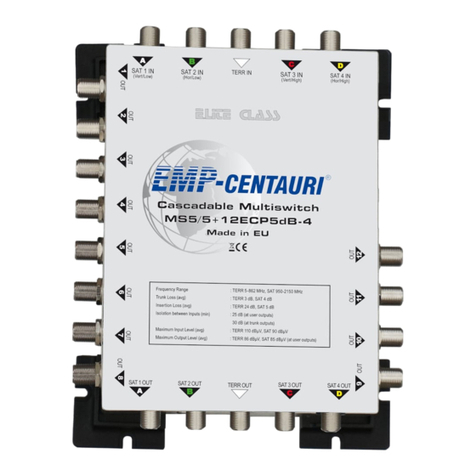
EMP-Centauri
EMP-Centauri MS5/5+12ECP5dB-4 instruction manual
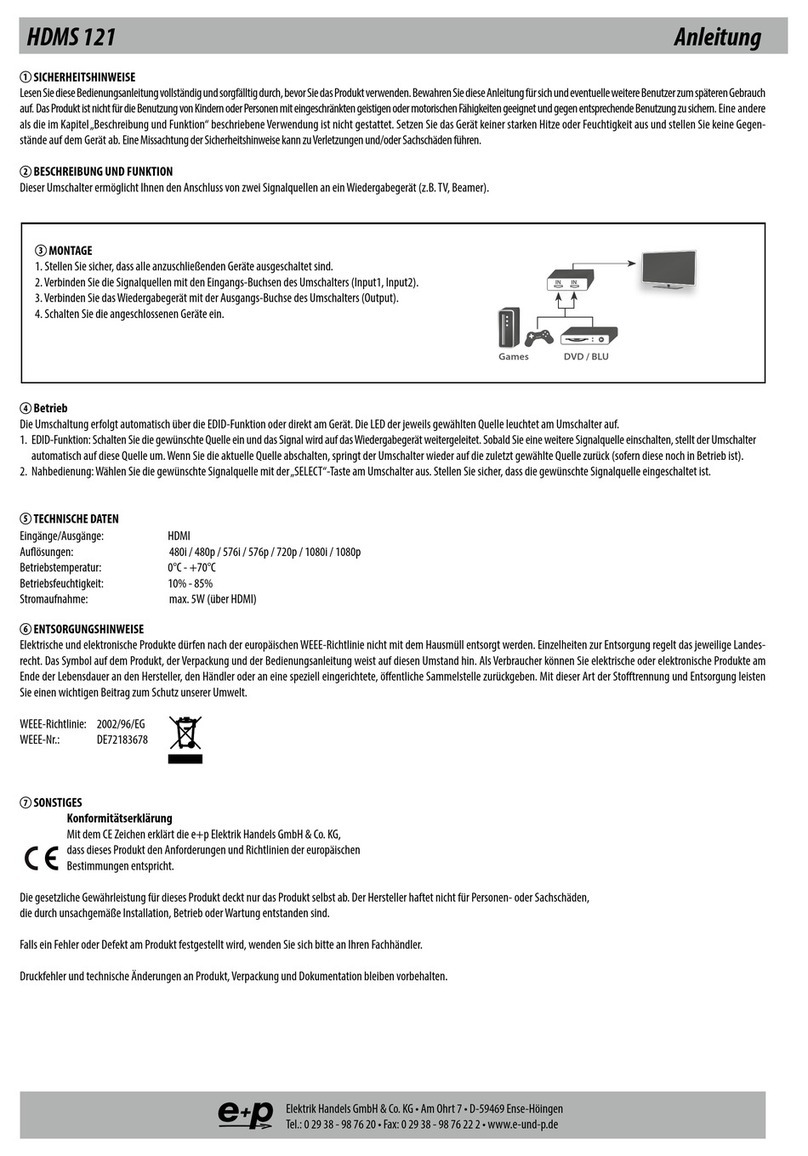
e+p
e+p HDMS 121 instruction manual
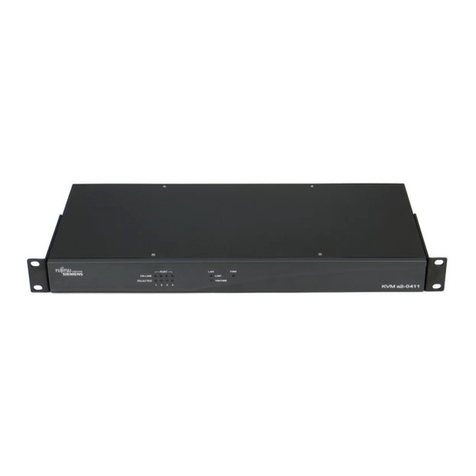
Fujitsu
Fujitsu KVM s2-0411 Quick installation guide

Weidmuller
Weidmuller IE-SW-IP67-5M12 Hardware installation guide

ICS Schneider Messtechnik
ICS Schneider Messtechnik PSA-31 operating instructions
